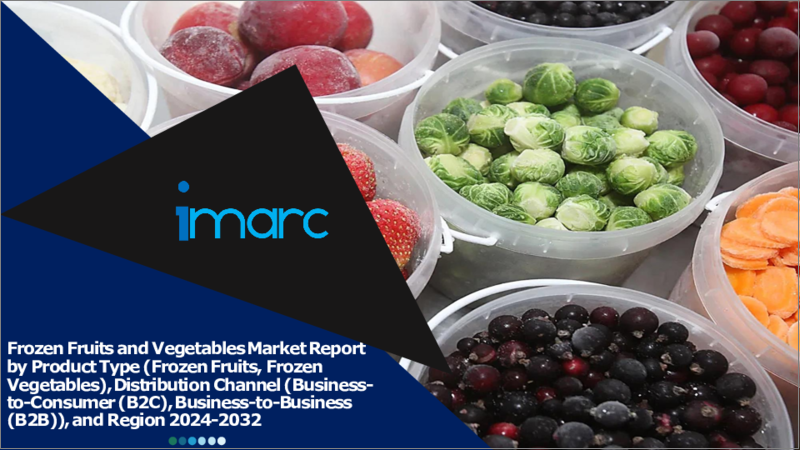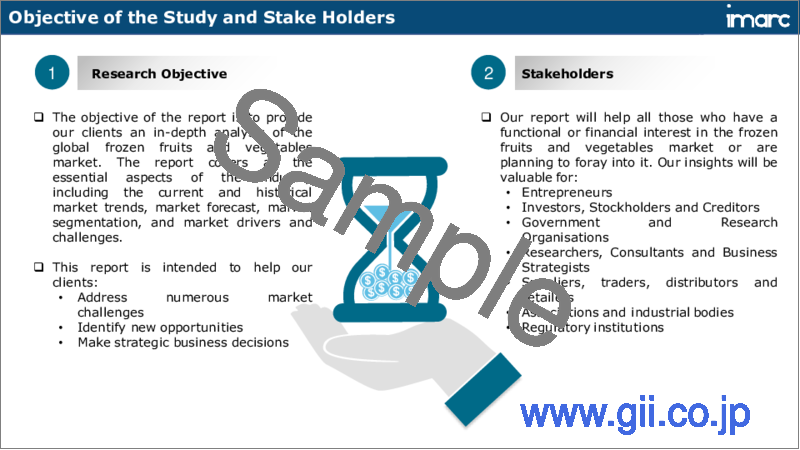|
|
市場調査レポート
商品コード
1450892
冷凍果物・野菜市場レポート:製品タイプ、流通チャネル、地域別2024-2032Frozen Fruits and Vegetables Market Report by Product Type (Frozen Fruits, Frozen Vegetables), Distribution Channel (Business-to-Consumer (B2C), Business-to-Business (B2B)), and Region 2024-2032 |
||||||
|
● お客様のご希望に応じて、既存データの加工や未掲載情報(例:国別セグメント)の追加などの対応が可能です。 詳細はお問い合わせください。 |
|||||||
| 冷凍果物・野菜市場レポート:製品タイプ、流通チャネル、地域別2024-2032 |
|
出版日: 2024年03月02日
発行: IMARC
ページ情報: 英文 148 Pages
納期: 2~3営業日
|
- 全表示
- 概要
- 図表
- 目次
世界の冷凍果物・野菜市場規模は2023年に270億米ドルに達しました。今後、IMARC Groupは、2024年から2032年にかけて2.3%の成長率(CAGR)を示し、2032年までに334億米ドルに達すると予測しています。
冷凍果物・野菜は、生鮮食品よりも幅広い利点があるため、消費者の間で急速に普及しています。果物や野菜の冷凍に採用されている技術は、これらの製品の色、風味、栄養価を保持するのに役立ちます。残留水分を氷に変えることで腐敗を遅らせ、バクテリアの繁殖を防ぐ。また、冷凍された果物や野菜は、激しい輸送や光、熱、埃にさらされることで起こる腐敗を防ぐことができます。冷凍食品には、低コスト、簡単な調理、オフシーズン中の入手など、数多くの利点があります。
長時間労働、健康志向の高まり、生活習慣病の増加により、消費者は洗ったり、皮をむいたり、刻んだりする必要がない冷凍野菜・果物にシフトしています。さらに、栄養摂取に影響を与えることなく、調理時間を最小限に抑えることができます。これに伴い、メーカー各社は、地元産のハーブやスパイスを取り入れたユニークな製品バリエーションを発売し、ポートフォリオを充実させ、多くの消費者層を取り込もうとしています。さらに、特にアジア諸国では、中間所得層の所得水準が上昇しており、市場の成長を後押ししています。さらに、消費者は現在、地理的な制約をなくすため、オンライン・ショッピングやクレジットカード/デビットカードでの支払いを好んでいます。これは、急成長するeコマース産業と相まって、市場成長を後押ししています。
本レポートで扱う主な質問
- 2023年の世界の冷凍果物・野菜市場規模は?
- 2024-2032年の世界の冷凍果物・野菜市場の予想成長率は?
- 世界の冷凍果物・野菜市場を牽引する主要因は何か?
- COVID-19が世界の冷凍果物・野菜市場に与えた影響は?
- 製品タイプに基づく世界の冷凍果物・野菜市場の内訳は?
- 冷凍果物・野菜の世界市場の流通チャネル別区分は?
- 冷凍果物・野菜の世界市場における主要地域は?
- 冷凍果物・野菜の世界市場における主要企業/企業は?
目次
第1章 序文
第2章 調査範囲と調査手法
- 調査目的
- 利害関係者
- データソース
- 一次情報
- 二次情報
- 市場推定
- ボトムアップアプローチ
- トップダウンアプローチ
- 調査手法
第3章 エグゼクティブサマリー
第4章 イントロダクション
- 概要
- 主要産業動向
第5章 世界の冷凍果物・野菜産業
- 市場概要
- 市場実績
- 数量動向
- 金額動向
- COVID-19の影響
- 価格とマージン分析
- 市場内訳:地域別
- 市場内訳:製品タイプ別
- 市場内訳:流通チャネル別
- 市場予測
- SWOT分析
- 概要
- 強み
- 弱み
- 機会
- 脅威
- バリューチェーン分析
- ポーターのファイブフォース分析
- 概要
- 買い手の交渉力
- 供給企業の交渉力
- ライバルの度合い
- 新規参入業者の脅威
- 代替品の脅威
- 市場促進要因・課題
第6章 主要地域の業績
- 北米
- 市場動向
- 市場予測
- 欧州
- 市場動向
- 市場予測
- アジア太平洋
- 市場動向
- 市場予測
- ラテンアメリカ
- 市場動向
- 市場予測
- 中東・アフリカ
- 市場動向
- 市場予測
第7章 実績:製品タイプ別
- 冷凍果物
- 市場動向
- 市場予測
- 冷凍野菜
- 市場動向
- 市場予測
第8章 実績:流通チャネル別
- 企業対消費者(B2C)
- 市場動向
- 市場内訳:チャネル別
- スーパーマーケット/ハイパーマーケット
- 市場動向
- 市場予測
- 独立小売業
- 市場動向
- 市場予測
- コンビニエンスストア
- 市場動向
- 市場予測
- オンライン
- 市場動向
- 市場予測
- その他
- 市場動向
- 市場予測
- スーパーマーケット/ハイパーマーケット
- 市場予測
- 企業間(B2B)
- 市場動向
- 市場予測
第9章 競合情勢
- 市場構造
- 主要企業
第10章 冷凍果物・野菜の製造工程
- 製品概要
- 詳細なプロセスフロー
- 様々な単位操作
- マスバランスと必要な原材料
第11章 プロジェクトの詳細、必要条件、費用
- 土地要件と費用
- 建設要件と費用
- 工場機械
- 機械写真
- 原材料の要件と支出
- 原材料と最終製品の写真
- 包装の要件と支出
- 輸送の要件と支出
- ユーティリティの要件と支出
- 人員要件と支出
- その他の設備投資
第12章 冷凍果物・野菜製造工場融資と資金援助
第13章 プロジェクトの経済性
- プロジェクトの資本コスト
- 技術経済パラメータ
- サプライチェーンの各段階における製品価格とマージン
- 収入予測
- 支出予測
- 課税と減価償却
- 財務分析
- 利益分析
第14章 主要企業のプロファイル
- Dole Food Company, Inc
- Ardo NV
- HJ Heinz
- Simplot Australia Pty. Ltd
- General Mills
List of Figures
- Figure 1: Global: Frozen Fruits and Vegetables Market: Major Drivers and Challenges
- Figure 2: Global: Frozen Fruits and Vegetables Market: Consumption Volume (in Million Tons), 2018-2023
- Figure 3: Global: Frozen Fruits and Vegetables Market: Consumption Value (in Billion US$), 2018-2023
- Figure 4: Global: Frozen Fruits and Vegetables Market: Average Prices (in US$/Ton), 2018-2032
- Figure 5: Global: Frozen Fruits and Vegetables Market: Breakup by Region (in %), 2023
- Figure 6: Global: Frozen Fruits and Vegetables Market: Breakup by Product Type (in %), 2023
- Figure 7: Global: Frozen Fruits and Vegetables Market: Breakup by Distribution Channel (in %), 2023
- Figure 8: Global: Frozen Fruits and Vegetables Market Forecast: Consumption Volume (in Million Tons), 2024-2032
- Figure 9: Global: Frozen Fruits and Vegetables Market Forecast: Consumption Value (in Billion US$), 2024-2032
- Figure 10: Global: Frozen Fruits and Vegetables Industry: SWOT Analysis
- Figure 11: Global: Frozen Fruits and Vegetables Industry: Value Chain Analysis
- Figure 12: Global: Frozen Fruits and Vegetables Industry: Porter's Five Forces Analysis
- Figure 13: North America: Frozen Fruits and Vegetables Market: Volume Trends (in Million Tons), 2018 & 2023
- Figure 14: North America: Frozen Fruits and Vegetables Market Forecast: Volume Trends (in Million Tons), 2024-2032
- Figure 15: Europe: Frozen Fruits and Vegetables Market: Volume Trends (in Million Tons), 2018 & 2023
- Figure 16: Europe: Frozen Fruits and Vegetables Market Forecast: Volume Trends (in Million Tons), 2024-2032
- Figure 17: Asia Pacific: Frozen Fruits and Vegetables Market: Volume Trends (in Million Tons), 2018 & 2023
- Figure 18: Asia Pacific: Frozen Fruits and Vegetables Market Forecast: Volume Trends (in Million Tons), 2024-2032
- Figure 19: Latin America: Frozen Fruits and Vegetables Market: Volume Trends (in Million Tons), 2018 & 2023
- Figure 20: Latin America: Frozen Fruits and Vegetables Market Forecast: Volume Trends (in Million Tons), 2024-2032
- Figure 21: Middle East and Africa: Frozen Fruits and Vegetables Market: Volume Trends (in Million Tons), 2018 & 2023
- Figure 22: Middle East and Africa: Frozen Fruits and Vegetables Market Forecast: Volume Trends (in Million Tons), 2024-2032
- Figure 23: Global: Frozen Fruits Market: Volume Trends (in Million Tons), 2018 & 2023
- Figure 24: Global: Frozen Fruits Market Forecast: Volume Trends (in Million Tons), 2024-2032
- Figure 25: Global: Frozen Vegetables Market: Volume Trends (in Million Tons), 2018 & 2023
- Figure 26: Global: Frozen Vegetables Market Forecast: Volume Trends (in Million Tons), 2024-2032
- Figure 27: Global: Frozen Fruits and Vegetables Market: Sales through Business-to-Consumer (in Million Tons), 2018 & 2023
- Figure 28: Global: Frozen Fruits and Vegetables Market: Sales through Supermarkets/Hypermarkets (in Million Tons), 2018 & 2023
- Figure 29: Global: Frozen Fruits and Vegetables Market Forecast: Sales through Supermarkets/Hypermarkets (in Million Tons), 2024-2032
- Figure 30: Global: Frozen Fruits and Vegetables Market: Sales through Independent Retailers (in Million Tons), 2018 & 2023
- Figure 31: Global: Frozen Fruits and Vegetables Market Forecast: Sales through Independent Retailers (in Million Tons), 2024-2032
- Figure 32: Global: Frozen Fruits and Vegetables Market: Sales through Convenience Stores (in Million Tons), 2018 & 2023
- Figure 33: Global: Frozen Fruits and Vegetables Market Forecast: Sales through Convenience Stores (in Million Tons), 2024-2032
- Figure 34: Global: Frozen Fruits and Vegetables Market: Online Sales (in Million Tons), 2018 & 2023
- Figure 35: Global: Frozen Fruits and Vegetables Market Forecast: Online Sales (in Million Tons), 2024-2032
- Figure 36: Global: Frozen Fruits and Vegetables Market: Sales through Other Distribution Channels (in Million Tons), 2018 & 2023
- Figure 37: Global: Frozen Fruits and Vegetables Market Forecast: Sales through Other Distribution Channels (in Million Tons), 2024-2032
- Figure 38: Global: Frozen Fruits and Vegetables Market Forecast: Sales through Business-to-Consumer (in Million Tons), 2024-2032
- Figure 39: Global: Frozen Fruits and Vegetables Market: Sales through Business-to-Business (in Million Tons), 2018 & 2023
- Figure 40: Global: Frozen Fruits and Vegetables Market Forecast: Sales through Business-to-Business (in Million Tons), 2024-2032
- Figure 41: Frozen Fruits and Vegetables Manufacturing: Detailed Process Flow
- Figure 42: Frozen Fruits and Vegetables Manufacturing Process: Conversion Rate of Feedstocks
- Figure 43: Frozen Fruits and Vegetables Manufacturing: Breakup of Capital Costs (in %)
- Figure 44: Frozen Fruits and Vegetables Industry: Margins Across Various Stages of the Supply Chain
- Figure 45: Frozen Fruits and Vegetables Production: Manufacturing Cost Breakup (in %)
List of Tables
- Table 1: Global: Frozen Fruits and Vegetables Market: Key Industry Highlights, 2023 and 2032
- Table 2: Global: Frozen Fruits and Vegetables Market Forecast: Breakup by Region (in Million Tons), 2024-2032
- Table 3: Global: Frozen Fruits and Vegetables Market Forecast: Breakup by Product Type (in Million Tons), 2024-2032
- Table 4: Global: Frozen Fruits and Vegetables Market Forecast: Breakup by Distribution Channel (in Million Tons), 2024-2032
- Table 5: Global: Frozen Fruits and Vegetables Market: Key Players
- Table 6: Frozen Fruits and Vegetables Manufacturing Plant: Raw Material Requirements (in Tons/Day)
- Table 7: Frozen Fruits and Vegetables Manufacturing Plant: Costs Related to Land and Site Development (in US$)
- Table 8: Frozen Fruits and Vegetables Manufacturing Plant: Costs Related to Civil Works (in US$)
- Table 9: Frozen Fruits and Vegetables Manufacturing Plant: Machinery Costs (in US$)
- Table 10: Frozen Fruits and Vegetables Manufacturing Plant: Raw Material Requirements (in Tons/Day)
- Table 11: Frozen Fruits and Vegetables Manufacturing Plant: Costs Related to Utilities
- Table 12: Frozen Fruits and Vegetables Manufacturing Plant: Costs Related to Salaries and Wages (in US$)
- Table 13: Frozen Fruits and Vegetables Manufacturing Plant: Costs Related to Other Capital Investments (in US$)
- Table 14: Details of Financial Assistance Offered by Financial Institutions
- Table 15: Frozen Fruits and Vegetables Manufacturing Plant: Capital Costs (in US$)
- Table 16: Frozen Fruits and Vegetables Manufacturing Plant: Techno-Economic Parameters
- Table 17: Frozen Fruits and Vegetables Manufacturing Plant: Income Projections (in US$)
- Table 18: Frozen Fruits and Vegetables Manufacturing Plant: Expenditure Projections (in US$)
- Table 19: Frozen Fruits and Vegetables Manufacturing Plant: Taxation (in US$)
- Table 20: Frozen Fruits and Vegetables Manufacturing Plant: Depreciation (in US$)
- Table 21: Frozen Fruits and Vegetables Manufacturing Plant: Cash Flow Analysis Without Considering the Income Tax Liability
- Table 22: Frozen Fruits and Vegetables Manufacturing Plant: Cash Flow Analysis on Considering the Income Tax Liability
- Table 23: Frozen Fruits and Vegetables Manufacturing Plant: Profit and Loss Account (in US$)
The global frozen fruits and vegetables market size reached US$ 27.0 Billion in 2023. Looking forward, IMARC Group expects the market to reach US$ 33.4 Billion by 2032, exhibiting a growth rate (CAGR) of 2.3% during 2024-2032.
Frozen fruits and vegetables are rapidly gaining traction among consumers as they offer a wide range of advantages over the fresh produce. The technique employed in freezing fruits and vegetables assists in retaining the color, flavor and nutritive value of these products. It slows down the decomposition by turning the residual moisture into ice, which prevents the growth of bacteria. Frozen fruits and vegetables are also immune to spoilage that occurs on account of vigorous transportation and exposure to light, heat and dust. They offer numerous benefits which include low cost, easy preparation and availability during the off-season.
Due to long working hours, rising health consciousness and the increasing prevalence of lifestyle diseases, consumers are shifting to frozen fruits and vegetables as they do not need to be washed, peeled or chopped. Additionally, they help in minimizing the overall cooking time without affecting the nutritional intake. In line with this, manufacturers are launching unique product variants, incorporating herbs and spices from local produce, to widen their portfolio and attract a large consumer base. Further, inflating income levels of the middle-class population, especially in the Asian countries, is impelling the market growth. Moreover, consumers currently prefer to shop online and pay through their credit/debit cards to eliminate geographical limitations. This, in confluence with the burgeoning e-commerce industry, is providing a thrust to the market growth.
Key Market Segmentation:
IMARC Group provides an analysis of the key trends in each sub-segment of the global frozen fruits and vegetables market report, along with forecasts at the global and regional level from 2024-2032. Our report has categorized the market based on product type and distribution channel.
Breakup by Product Type:
Frozen Fruits
Frozen Vegetables
The market is primarily dominated by frozen vegetables. This can be attributed to hectic lifestyles of consumers and the growing demand for easy-to-cook food products. Moreover, the increasing number of large retail chains and frequent usage of these vegetables in homes as well as restaurants is also boosting their overall sales.
Breakup by Distribution Channel:
Business-to-Consumer (B2C)
Supermarkets/Hypermarkets
Independent Retailers
Convenience Stores
Online
Others
Business-to-Business (B2B)
Based on the distribution channel, the market is dominated by the Business-to-Consumer (B2C) segment, wherein supermarkets/hypermarkets represent the leading subsegment.
Regional Insights:
North America
Europe
Asia Pacific
Latin America
Middle East and Africa
On the geographical front, Europe represents the largest market for frozen fruits and vegetables around the world. Frozen berries are widely used as a key ingredient for preparing smoothies and similar products in the region. This, coupled with the rising demand for frozen kale (a type of cabbage), which is used in the preparation of chips, salads and smoothies, is supporting the market growth in the region.
Competitive Landscape:
The competitive landscape of the market has been analyzed in the report, along with the detailed profiles of the key players operating in the industry. Some of these key players include:
Dole Food Company, Inc
Ardo NV
HJ Heinz
Simplot Australia Pty. Ltd
General Mills
Key Questions Answered in This Report
- 1. What was the size of the global frozen fruits and vegetables market in 2023?
- 2. What is the expected growth rate of the global frozen fruits and vegetables market during 2024-2032?
- 3. What are the key factors driving the global frozen fruits and vegetables market?
- 4. What has been the impact of COVID-19 on the global frozen fruits and vegetables market?
- 5. What is the breakup of the global frozen fruits and vegetables market based on the product type?
- 6. What is the breakup of the global frozen fruits and vegetables market based on the distribution channel?
- 7. What are the key regions in the global frozen fruits and vegetables market?
- 8. Who are the key players/companies in the global frozen fruits and vegetables market?
Table of Contents
1 Preface
2 Scope and Methodology
- 2.1 Objectives of the Study
- 2.2 Stakeholders
- 2.3 Data Sources
- 2.3.1 Primary Sources
- 2.3.2 Secondary Sources
- 2.4 Market Estimation
- 2.4.1 Bottom-Up Approach
- 2.4.2 Top-Down Approach
- 2.5 Forecasting Methodology
3 Executive Summary
4 Introduction
- 4.1 Overview
- 4.2 Key Industry Trends
5 Global Frozen Fruits and Vegetables Industry
- 5.1 Market Overview
- 5.2 Market Performance
- 5.2.1 Volume Trends
- 5.2.2 Value Trends
- 5.3 Impact of COVID-19
- 5.4 Price and Margin Analysis
- 5.5 Market Breakup by Region
- 5.6 Market Breakup by Product Type
- 5.7 Market Breakup by Distribution Channel
- 5.8 Market Forecast
- 5.9 SWOT Analysis
- 5.9.1 Overview
- 5.9.2 Strengths
- 5.9.3 Weaknesses
- 5.9.4 Opportunities
- 5.9.5 Threats
- 5.10 Value Chain Analysis
- 5.11 Porters Five Forces Analysis
- 5.11.1 Overview
- 5.11.2 Bargaining Power of Buyers
- 5.11.3 Bargaining Power of Suppliers
- 5.11.4 Degree of Rivalry
- 5.11.5 Threat of New Entrants
- 5.11.6 Threat of Substitutes
- 5.12 Key Market Drivers and Challenges
6 Performance of Key Regions
- 6.1 North America
- 6.1.1 Market Trends
- 6.1.2 Market Forecast
- 6.2 Europe
- 6.2.1 Market Trends
- 6.2.2 Market Forecast
- 6.3 Asia Pacific
- 6.3.1 Market Trends
- 6.3.2 Market Forecast
- 6.4 Latin America
- 6.4.1 Market Trends
- 6.4.2 Market Forecast
- 6.5 Middle East and Africa
- 6.5.1 Market Trends
- 6.5.2 Market Forecast
7 Performance by Product Type
- 7.1 Frozen Fruits
- 7.1.1 Market Trends
- 7.1.2 Market Forecast
- 7.2 Frozen Vegetables
- 7.2.1 Market Trends
- 7.2.2 Market Forecast
8 Performance by Distribution Channel
- 8.1 Business-to-Consumer (B2C)
- 8.1.1 Market Trends
- 8.1.2 Market Breakup by Channel
- 8.1.2.1 Supermarkets/Hypermarkets
- 8.1.2.1.1 Market Trends
- 8.1.2.1.2 Market Forecast
- 8.1.2.2 Independent Retailers
- 8.1.2.2.1 Market Trends
- 8.1.2.2.2 Market Forecast
- 8.1.2.3 Convenience Stores
- 8.1.2.3.1 Market Trends
- 8.1.2.3.2 Market Forecast
- 8.1.2.4 Online
- 8.1.2.4.1 Market Trends
- 8.1.2.4.2 Market Forecast
- 8.1.2.5 Others
- 8.1.2.5.1 Market Trends
- 8.1.2.5.2 Market Forecast
- 8.1.2.1 Supermarkets/Hypermarkets
- 8.1.3 Market Forecast
- 8.2 Business-to-Business (B2B)
- 8.2.1 Market Trends
- 8.2.2 Market Forecast
9 Competitive Landscape
- 9.1 Market Structure
- 9.2 Key Players
10 Frozen Fruits and Vegetables Manufacturing Process
- 10.1 Product Overview
- 10.2 Detailed Process Flow
- 10.3 Various Unit Operations Involved
- 10.4 Mass Balance and Raw Materials Required
11 Project Details, Requirements and Costs Involved
- 11.1 Land Requirements and Expenditures
- 11.2 Construction Requirements and Expenditures
- 11.3 Plant Machinery
- 11.4 Machinery Pictures
- 11.5 Raw Material Requirements and Expenditures
- 11.6 Raw Material and Final Product Pictures
- 11.7 Packaging Requirements and Expenditures
- 11.8 Transportation Requirements and Expenditures
- 11.9 Utilities Requirements and Expenditures
- 11.10 Manpower Requirements and Expenditures
- 11.11 Other Capital Investments
12 Frozen Fruits and Vegetables Manufacturing Plant: Loans and Financial Assistance
13 Project Economics
- 13.1 Capital Cost of the Project
- 13.2 Techno-Economic Parameters
- 13.3 Product Pricing and Margins Across Various Levels of the Supply Chain
- 13.4 Income Projections
- 13.5 Expenditure Projections
- 13.6 Taxation and Depreciation
- 13.7 Financial Analysis
- 13.8 Profit Analysis
14 Key Player Profiles
- 14.1 Dole Food Company, Inc
- 14.2 Ardo NV
- 14.3 HJ Heinz
- 14.4 Simplot Australia Pty. Ltd
- 14.5 General Mills




